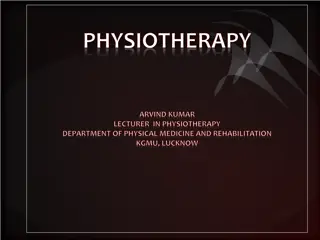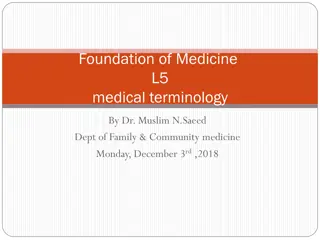System Models in Software Engineering: A Comprehensive Overview
System models play a crucial role in software engineering, aiding in understanding system functionality and communicating with customers. They include context models, behavioural models, data models, object models, and more, each offering unique perspectives on the system. Different types of system
5 views • 33 slides
Importance of Fitness Testing in Physical Education
Health-related physical activity (HRPA) stresses the need to view fitness testing as a tool to promote increased physical activity levels rather than an end goal. The focus in school physical education is on equipping youth with the knowledge and skills for lifelong health. Fitness test protocols sh
0 views • 17 slides
The muscular system
The muscular system is a vital organ system that includes smooth, skeletal, and cardiac muscles. It plays a crucial role in locomotion, supporting the cardiovascular system, enabling lung ventilation, regulating fluids, maintaining posture, and generating heat in the body. This system consists of ar
2 views • 16 slides
Assessment and Diagnostic Tests in Musculoskeletal System Pain
Pain in musculoskeletal conditions varies, such as bone pain described as dull and deep, muscular pain as soreness, fracture pain as sharp, and joint pain worsens with movement. Specific assessments by nurses include checking body alignment, joint symmetry, signs of inflammation, pressure sources, a
7 views • 38 slides
Aerobics Training: Introduction, Benefits, and Types by Dr. Amita Handa
Join Dr. Amita Handa's Semester 3 Physical Education course on Aerobics Training at Shivaji College, University of Delhi, to learn about the introduction, benefits, and different types of aerobics. Explore the evolution of aerobics, individualized and group training methods, and the impact on overal
0 views • 29 slides
Livestock Anatomy and Body Systems
Explore the anatomy of livestock, including the form, structure, and systems of the body. Learn about the skeletal, muscular, sensory, nervous, circulatory, respiratory, digestive, urinary, and reproductive systems. Discover body cavities, directions, and different systems and understand the functio
0 views • 34 slides
Biomechanics in Physical Education: Movement Analysis Overview
Biomechanics plays a crucial role in understanding movement and technique in physical education. This resource focuses on topics such as muscular contractions, lever systems, planes and axes of movement, and sports technology. It helps sports performers and coaches analyze movements for performance
2 views • 50 slides
Enhancing Performance in Rounders: Fitness, Skills, and Drills
Explore the key fitness components impacting performance in Rounders like aerobic endurance, muscular strength, and more. Understand essential skills and tactics required in the game, such as batting and long barrier techniques. Engage in useful practice drills to improve skills like batting and lon
0 views • 14 slides
Football Skills and Practices for Improved Performance
Enhance your football performance with a focus on fitness components like aerobic endurance, muscular endurance, flexibility, speed, muscular strength, body composition, as well as honing skills such as passing, shooting, and dribbling. Practice passing accuracy and shooting techniques to score goal
0 views • 14 slides
System Modeling in Engineering
System modeling in engineering involves developing abstract models to represent a system from various perspectives using graphical notations like UML. These models aid in understanding system functionality, communicating with stakeholders, and documenting requirements for new systems. Existing and p
5 views • 53 slides
The Function of Muscles - Our Amazing Muscular System
Our muscles play a vital role in our bodies by helping us move, pump blood, digest food, and breathe. They are made up of muscle fibers and connected to bones by tendons. The muscles work by contracting and relaxing when we move. To keep our muscles healthy, it's important to engage in physical acti
0 views • 6 slides
Anesthesia Considerations for Neuromuscular Disorders: Overview and Management
This informative document discusses the classification of neuromuscular disorders, focusing on muscle and muscle membrane disorders such as Muscular Dystrophy. It delves into the characteristics, pathology, and clinical presentations of different types of muscular dystrophies, including Duchenne and
0 views • 42 slides
Importance of Flexibility and Stretching for Better Health and Injury Prevention
Flexibility and stretching play a crucial role in preventing injuries, promoting better health, and preparing the body for physical activities. Adequate muscular flexibility allows joints to move efficiently, reducing the risk of compressing tissues or nerves. By incorporating proper stretching tech
0 views • 17 slides
Introduction to Physiotherapy: Modalities and Exercise Therapy
Physiotherapy, a branch of medical science, utilizes various modalities like electric current, heat/cold, water, and exercises for therapeutic treatment. It includes exercise therapy with active and passive movements, electrotherapy, thermotherapy, hydrotherapy, and massage. Active movements involve
4 views • 42 slides
Innovative Hand Orthosis Development for Duchenne Muscular Dystrophy Patients
Develop an intuitive hand orthosis to support individuals with Duchenne Muscular Dystrophy (DMD). The project aims to enhance active hand support through high-tech, multi-DOF orthoses designed by a team of researchers focusing on control strategies, functional development, and integration with exist
0 views • 9 slides
Fun & Fit Festival for KS1 Color Groups: 10 Activities for School Delivery
Milton Keynes School Sport Partnership presents a Fun & Fit Festival for KS1 students. The festival, to be delivered in school in color groups, features 10 engaging activities promoting physical development. Children will enjoy activities like Kangaroo Hop for muscular endurance, Elephant Push for s
0 views • 11 slides
Badminton Skills and Fitness Components Analysis
Exploring key fitness components like aerobic endurance, muscular endurance, flexibility, speed, muscular strength, body composition, their impact on badminton performance, alongside detailed descriptions. Delve into essential badminton skills and tactics like the backhand serve, high serve, and ove
0 views • 14 slides
Components of Physical Fitness
Explore the various components of physical fitness such as flexibility, cardiovascular endurance, muscular strength, muscular endurance, and body composition. Learn the difference between health-related and skill-related fitness, identify the components of health-related fitness, and discover how th
0 views • 31 slides
Overview of the Cardiovascular System and Arterial Blood Vessels
The cardiovascular system includes the heart, arteries, veins, and capillaries, responsible for the transport of blood and lymph throughout the body. Arterial blood vessels are classified based on diameter into large (elastic) arteries, medium (muscular) arteries, and arterioles. The arterial wall c
0 views • 13 slides
The Muscular System: Functions & Importance
Muscles are essential for movement, posture, circulation, and digestion in the human body. Without a properly functioning muscular system, vital processes like breathing and food digestion would be compromised. Maintaining muscle health through exercise and a nutritious diet is crucial to ensure opt
0 views • 11 slides
Teaching Pronunciation Techniques and Drills for Effective Learning
Explore teaching techniques and drills for pronunciation focusing on activities like awareness exercises, games, and drills based on minimal pairs. Emphasizing the importance of physical activities in developing muscular flexibility for better pronunciation skills.
1 views • 25 slides
Benefits and Elements of Physical Activity Study Guide
Explore the benefits of physical activity for physical, mental, and social health, as well as the negative effects of a sedentary lifestyle. Learn about the elements of fitness including cardiorespiratory endurance, muscular strength, muscle endurance, flexibility, and body composition. Discover how
0 views • 19 slides
Overview of Histology: Study of Tissues and Organs
Histology involves studying the tissues of the body and how they form organs. Tissues consist of cells and extracellular matrix, with functions like support, nutrient transport, and waste removal. The human body comprises epithelial, connective, muscular, and nervous tissues, each with specific func
0 views • 4 slides
Pharynx Anatomy and Physiology Overview
Pharynx serves as a crucial space connecting respiratory and digestive systems, divided into nasopharynx, oropharynx, and laryngopharynx. It houses important structures like mucous membrane, submucosa, muscular layers, and neurovasculature. Understanding pharynx anatomy is essential for diagnosing a
0 views • 20 slides
Benefits of Exercise Therapy in Nonalcoholic Fatty Liver Disease (NAFLD)
Exercise therapy plays a crucial role in managing nonalcoholic fatty liver disease (NAFLD) by improving hepatic aminotransferases and reducing steatosis. Lifestyle modifications, including increased physical activity, are essential in the treatment of NAFLD. This includes aerobic exercise, resistanc
0 views • 32 slides
Effective Application of FITT Principle for Muscular Strength and Endurance Training
Utilize the FITT Principle to design a workout plan for enhancing muscular endurance and strength. Understand the frequency, intensity, time, and types of exercises needed for optimal results. Modify and adjust elements regularly to prevent plateaus and overuse injuries. Focus on FIIT and injury pre
0 views • 14 slides
A Comparison of Human and Frog Anatomy and Physiology
Humans and frogs share many similarities in their organ systems such as lungs, digestive, circulatory, skeletal, and muscular systems. However, there are also significant differences in body configuration, respiratory system, skeletal structure, and reproductive system. Frogs have unique features li
0 views • 7 slides
The Muscular System and Its Anatomy
The muscular system is vital for movement, posture maintenance, and organ protection. It consists of skeletal muscles that contract to create movement, circular muscles called sphincters for controlling openings, and muscle fibers arranged in fascicles with collagen layers like epimysium and endomys
0 views • 59 slides
Respiratory Care in FSHD: Guidelines and Management Overview
Comprehensive overview of respiratory care in Facioscapulohumeral Muscular Dystrophy (FSHD) based on the American Academy of Neurology guidelines. Covers incidence of respiratory insufficiency, assessment of lung function, treatment options including noninvasive ventilation, and strategies for maint
0 views • 16 slides
Comprehensive Guide to Human Body Systems, Conditions, and Treatments
Explore fascinating images and information on the human body, its various systems like digestive, circulatory, respiratory, skeletal, muscular/nervous, reproductive, common conditions such as hay fever, arthritis, and their symptoms, causes, and treatments. Learn about treatment vocabulary, tips to
0 views • 22 slides
The Musculoskeletal System in the Human Body
The musculoskeletal system, comprising the muscular and skeletal systems, supports body movement, stability, and shape. It includes muscles, bones, tendons, ligaments, and joints. This system serves functions like providing support, protection to vital organs, mediating movement, and producing blood
0 views • 36 slides
The Anatomy of the Stomach
The stomach, also known as the gaster or venter, is a vital organ in the digestive system. It is a muscular bag that plays a crucial role in food digestion and absorption. This article covers the surface anatomy, external and internal features, blood supply, nerve supply, lymphatic drainage, clinica
0 views • 32 slides
Emergency Slaughter Procedures in Livestock Management
Emergency slaughter of animals is conducted in cases of accidents or diseases, with common reasons including fractures, injuries, respiratory distress, difficult parturition, and others. Electrical stimulation of carcasses is employed for benefits like increased tenderness and flavor. Hot deboning o
0 views • 18 slides
Approach to Acute Flaccid Paralysis in Children: Evaluation and Management
Acute muscular weakness in children is a neurological emergency defined by sudden onset muscle weakness or paralysis in less than 5 days. When evaluating a child with acute flaccid paralysis, consider factors like onset rhythm, associated symptoms, and past medical history. A thorough physical and n
0 views • 45 slides
Overview of Muscle Disorders and Muscular Dystrophies
The human body consists of over 600 muscles, divided into skeletal, smooth, and cardiac muscles. Diseases of skeletal muscle encompass myopathy, myositis, and muscular dystrophy. Muscle disorders are categorized into genetic muscular dystrophies, channelopathies, inflammatory myopathies, and endocri
0 views • 32 slides
Gastrointestinal Function and Its Regulation by Drugs
The gastrointestinal tract, a muscular tube from the mouth to the anus, is influenced by drugs affecting its function. Structures vary in different animals, with control by the autonomic nervous system branches. Parasympathetic stimulation increases motility, while sympathetic stimulation decreases
0 views • 36 slides
Major Body Systems and Cavities in Human Anatomy
Understanding the major body systems, including skeletal, muscular, cardiovascular, lymphatic, immune, respiratory, digestive, urinary, nervous, endocrine, reproductive, integumentary, and special senses systems, as well as the dorsal cavity comprised of the cranial and spinal cavities. Each system
0 views • 20 slides
Muscular System Jeopardy - Learn About Muscle Functions and Facts
Explore the Muscular System Jeopardy game to understand how muscles work, muscle group names, exercises to build muscles, and the importance of healthy muscles. Discover interesting facts about muscle function, including how messages from the brain trigger muscle contractions, the role of tendons in
0 views • 52 slides
Muscular Dystrophy
Muscular Dystrophy is a debilitating disease affecting muscle function. Learn how it impacts individuals and explore research efforts aimed at finding treatments and support strategies for affected individuals and families.
0 views • 26 slides
Managing End-Stage Duchenne Muscular Dystrophy Care
This presentation discusses the complex care needs of John, a young man with end-stage Duchenne Muscular Dystrophy. It highlights the challenges faced by John and his caregivers, emphasizing the importance of a collaborative medical neighborhood approach to provide optimal care and support. The cont
0 views • 10 slides







































